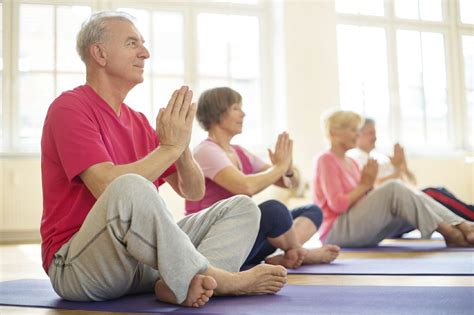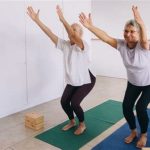Is Yoga Safe for Seniors? Key Considerations and Practical Insights
As yoga becomes increasingly popular among all age groups, its appeal to seniors has grown significantly. But is yoga safe for seniors, and what should they consider before starting a practice? In this article, we’ll explore the benefits, risks, and best practices of yoga for seniors, as well as how to create a routine that maximizes safety while promoting physical, mental, and emotional well-being.
Introduction
Yoga, a holistic practice that integrates physical poses, breathwork, and meditation, offers numerous health benefits for people of all ages. However, seniors face unique challenges, such as reduced flexibility, balance issues, and pre-existing health conditions, which can complicate their participation. This article will address the key considerations seniors should take into account before embarking on a yoga practice, offer practical solutions to potential risks, and highlight safe modifications to common yoga poses.
Key Concepts
Before diving into specifics, it’s essential to clarify the fundamental concepts related to yoga for seniors:
- Modifications: Adjustments to traditional yoga poses that make them accessible to seniors with limited mobility.
- Chair Yoga: A practice that allows seniors to perform yoga while seated, reducing strain on joints and promoting safety.
- Balance & Stability: The focus on exercises that improve balance to prevent falls, which are a common concern for older adults.
- Breath Control: The practice of pranayama (breath regulation) is essential for calming the nervous system and improving respiratory health.
Historical Context
Yoga’s origins can be traced back over 5,000 years to ancient India, where it was primarily a spiritual practice. Over time, it evolved to include physical postures and breathing techniques, eventually spreading across the globe. Yoga first gained popularity in the West in the 20th century, but it wasn’t until more recently that specialized forms of yoga tailored to seniors began to emerge. The rise of geriatric yoga programs in the late 20th century provided a blueprint for safe, modified practices, allowing seniors to enjoy the benefits of yoga without the risks associated with more intense forms.
Current State Analysis
Today, yoga is widely recognized for its ability to improve flexibility, strength, and mental clarity. But as more seniors take up yoga, the question of safety has become increasingly important. There is a growing body of research that highlights both the benefits and the potential risks. According to a 2022 study, yoga significantly improves mobility in seniors, yet improper practice or insufficient guidance can lead to injuries, especially in the joints and lower back. While many seniors benefit from group classes or online videos, the need for tailored, individualized guidance is paramount to prevent injuries.
Practical Applications
To ensure yoga is safe and beneficial for seniors, it’s crucial to adapt the practice to their unique needs. Here are some practical applications:
- Choose the Right Style: Gentle yoga, Hatha, or restorative yoga are ideal for seniors as they emphasize slow, deliberate movements.
- Use Props: Props such as blocks, straps, and chairs can help seniors modify poses, reducing strain on muscles and joints.
- Focus on Balance: Seniors should prioritize poses that strengthen their core and improve stability, such as Tree Pose or Mountain Pose.
- Listen to the Body: Seniors must learn to recognize their limits and avoid pushing themselves too hard.
Case Studies
Several real-world examples highlight the benefits and precautions of yoga for seniors:
| Case Study | Challenge | Solution |
|---|---|---|
| John, 72, with Arthritis | Painful joints made traditional poses difficult. | John began practicing chair yoga, allowing him to avoid floor-based poses while maintaining flexibility. |
| Margaret, 68, with Balance Issues | She experienced difficulty with standing poses. | Margaret focused on seated postures and used a wall for support in standing poses. |
| Linda, 75, Post-Surgery | After a hip replacement, Linda struggled with mobility. | Her instructor designed a routine that focused on gentle stretching and breathwork to aid in recovery. |
Stakeholder Analysis
There are several key stakeholders involved in promoting safe yoga practices for seniors:
- Seniors: The primary participants, whose health and safety must be prioritized.
- Yoga Instructors: Professionals who need to be trained in senior-specific modifications and safety measures.
- Healthcare Providers: Medical professionals who can offer advice on the suitability of yoga for individual seniors, considering pre-existing conditions.
- Family Members: They can support seniors by encouraging safe practices and helping them choose appropriate classes or instructors.
Implementation Guidelines
To implement a safe yoga practice for seniors, follow these guidelines:
- Consult a Physician: Seniors should always check with their healthcare provider before starting yoga, especially if they have health concerns.
- Start Slow: Beginners should ease into yoga by starting with shorter sessions, gradually increasing the duration as they build strength and flexibility.
- Find a Qualified Instructor: Working with an instructor experienced in teaching seniors is crucial for proper guidance and injury prevention.
- Use Props: Props like blocks, straps, and chairs should be integrated into the practice to modify poses and make them safer.
- Adapt Poses: Choose yoga poses specifically adapted to the needs and limitations of seniors. Avoid complex or overly strenuous postures.
Ethical Considerations
As yoga for seniors grows in popularity, it’s important to address ethical considerations:
- Informed Consent: Seniors should be fully informed about the risks and benefits of yoga and make choices based on their health conditions.
- Accessibility: Classes should be inclusive, ensuring that all seniors, regardless of ability, can participate safely.
- Avoiding Commercial Exploitation: Yoga for seniors should not be marketed with unrealistic promises of healing or cure, but rather with honesty about its benefits and limitations.
Limitations and Future Research
While yoga offers many benefits for seniors, there are limitations to its effectiveness. For example, yoga may not be suitable for seniors with severe mobility issues or those recovering from major surgeries without medical supervision. More research is needed to explore the long-term effects of yoga on chronic conditions like osteoporosis and arthritis. Additionally, studies comparing different types of yoga in senior populations could help tailor practices more precisely to individual needs.
Expert Commentary
Experts agree that yoga can be a safe and effective practice for seniors when done correctly. However, the key lies in proper guidance, modifications, and listening to one’s body. Dr. Susan Adler, a geriatric specialist, emphasizes, “Seniors should prioritize low-impact exercises, and yoga can be highly beneficial when practiced mindfully. The use of props and customized routines helps avoid strain while promoting overall well-being.”








